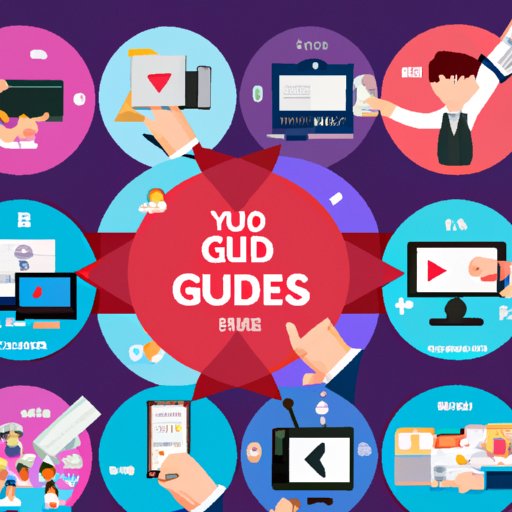How to Make a YouTube Video: A Step-by-Step Guide
YouTube has become one of the most popular social media platforms with a billion users, and it’s no wonder why so many people are turning to it as a way to share their voices, stories, and creative content. If you are thinking about creating a YouTube video, it can feel daunting to get started, but with this step-by-step guide, you can learn how to make a YouTube video from start to finish!
Pre-Production
Before you start filming, it is essential to plan and prepare for your video content carefully. You need to brainstorm ideas and plan out a rough outline of the content you want to create. Think about what your message is and what you want your viewers to take away from the video. Here are some tips for pre-production:
Brainstorming and Idea Generation
Brainstorming is an excellent way to generate ideas for your YouTube video. You can start by writing down any topic that interests you and then brainstorm different angles or approaches you can take to bring value to your viewers. You can also look up what’s trending on YouTube and see if you can create a video that adds to the discussion or offer a brand new perspective.
Scripting and Storyboarding
Once you have a clear idea of what your video will be about, it’s time to start scripting and storyboarding. Writing a script helps you stay organized and stick to the main points you want to make in your video. A storyboard is a visual representation of your script, and it helps you plan out your shots and camera angles.
Production
Once you have your plan in place, it’s time to start filming! Here are some tips to keep in mind during production:
Equipment Needs
You don’t need a lot of expensive equipment to make a great YouTube video, but having the right tools can make a big difference. Here is a list of some of the basic gear you will need:
- A Camera: You can use your smartphone camera, or you can invest in a higher-quality camera if you want better video quality.
- Lighting: Good lighting can make your video look more professional. You can use natural light or invest in a lighting kit.
- Microphone: Good audio quality is just as important as good video quality. You can use a microphone attached to your camera, an external microphone, or a lapel mic.
Filming
Here are some important things to keep in mind while filming:
- Framing: Make sure your subject is in the center of the frame and the camera is steady.
- Composition: Use the rule of thirds to make your shots more visually interesting.
- Audio Recording: Make sure you are recording audio from a microphone so that it comes out clear and crisp.
Capturing B-roll and Cutaways
B-roll footage refers to the extra footage that you can add to your video to keep things interesting, especially when you are talking about a specific topic that may not be visually stimulating. Cutaways are a way to add a visual change of pace, such as showing your audience a close-up of something you are talking about.
Post-Production
Once you have all your footage, it’s time to start piecing it together in the editing phase. Some things to keep in mind are:
Editing Process
Here is the step-by-step process of editing a video:
- Import Footage: Bring your footage into a video editing software such as Adobe Premiere.
- Assemble a Rough Cut: Use your storyboard and script as a guide and lay down all the footage in the order you want it to appear.
- Refine the Edit: Fine-tune your edit by trimming unnecessary footage, adjusting the length of shots, and adding transitions.
Adding Music, Sound Effects, and Graphics
Adding music and sound effects to your video can help keep the pacing and add a level of emotional depth. Graphics or text overlays can be helpful in enhancing key points or data-driven material.
Exporting and Rendering the Final Video
Once your video is edited, you need to export and render it so that it is ready to be uploaded on YouTube. Exporting the file allows you to adjust the final settings such as the resolution, codec, and file format. Rendering the video makes sure that all of the edits are in order and it is ready to be uploaded online.
Uploading and promoting
After your video is polished and finished, you need to set it up and promote it. Here are some things to keep in mind:
Optimizing the Video For Search
To make sure your video gets seen by the right audience, you need to use keywords in your title and description. Optimize your title and description to be informative, concise, and accurate to your content.
Using Titles, Descriptions, and Tags
You need to make sure that your titles, descriptions, and tags align with your content. Be clear and concise in your messaging, and make sure your tags use relevant keywords that will help your videos show up in YouTube’s algorithm.
Promoting Your Video on Social Media and Other Platforms
You can also promote your video outside of YouTube by sharing your video on social media, email newsletters, and personal blogs. Encourage viewers to leave comments, like, and share!
Conclusion
Congratulations! You now have the knowledge to make your own YouTube video from start to finish. Just remember that every aspect of the video-making process has an important role in creating a polished and professional-looking video for your audience to enjoy and learn from. Keep on learning new ways to improve, and you can create content that connects and resonates with viewers everywhere.
Resources:
- YouTube Creator Academy – free online training and tutorials for creators on the platform.
- Filmora Bootcamp – free online tutorials on video production and editing for YouTube.
- PremiumBeat’s – collection of articles and resources on how to make YouTube videos.
